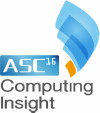 The largest student cluster competition in the known world kicked off Monday in Wuhan (or Woohan! as I call it), China. Sixteen teams representing universities from China, South America, the US, and Europe are participating in the fifth annual Asia Student Supercomputer Challenge.
The largest student cluster competition in the known world kicked off Monday in Wuhan (or Woohan! as I call it), China. Sixteen teams representing universities from China, South America, the US, and Europe are participating in the fifth annual Asia Student Supercomputer Challenge.
This competition just gets bigger and bigger.This year, it started with 175 teams of undergraduate students vying to get into the finals by proving that they know their stuff when it comes to HPC and supercomputers. The field was winnowed down to the sixteen best and brightest, who were then invited to the finals in Woohan (Wuhan).
HUST, the Huazhong University of Science and Technology hosts the final phase of the competition this year.
The undergraduate teams in the HUST finals configure and build their own supercomputer from Inspur-supplied building blocks. The teams can build as large a system as they want, as long as it doesn’t consume more than 3,000 watts during the competition.
Teams then compete to turn in the best results on two HPC benchmarks (HPL and HPCG), plus other scientific applications including:
MASNUM-WAM This sounds a lot like the name of an Asian boy band but is actually a software application that does some very interesting things. As some of you may know, about 71% of the Earth’s surface is covered by water. (This figure doesn’t even include the water in bottles, cans, or basements.) This water tends to slosh around some due to earthquakes, storms, and the like. In the cluster competition, MASNUM-WAM is being used as a numerical wave modeler to predict the behavior of large bits of water.
Aibinit is an application used to figure out the total energy, charge density, and structure of structures made out of electrons and nuclei – like atoms and things. It also does many other complicated things like performing molecular dynamics simulations using Density Functional Theory (DFT) forces or, if you’re in the mood, generating dynamical matrices.
DNN is an interesting challenge to the students. They’ll be using a chunk of Tianhe-2, the largest supercomputer in the world, to teach a Deep Neural Network. What they’re teaching it, I’m not sure; but they’re using hardware that consists of eight 2-Xeon nodes, each equipped with three Xeon Phi accelerators. In order to complete this task, they’ll have to optimize their Tianhe-2 cluster to achieve max performance on the data set supplied by competition organizers.
Mystery Application (ABySS) is a de novo (meaning “from the new”), parallel, gene sequence assembler that is designed to pin together short reads into a longer genomes. A use case: if you have a bunch of short cat genome sequences spread around your lab and you want to tie them together in order to analyze a longer genome or to spot changes, you’d just fire up ABySS and let it do its thing – easy peasy.
Not an easy slate of applications for budding supercomputer jockeys.
This competition is different from the SC and ISC versions in that there are several cash awards for winners in various categories. The most popular two teams (as judged by Tweets and WeChats) each win 5,000 RMB (about $770 US), while the winner of LINPACK receives 10,000 RMB (about $1,540 US).
Each of four winners of the “Application Innovation Award,” given to teams who have turned in the best app optimizations, receives 10,000 RMB. The winner of the ePrize, which competition organizers would like to see become the Gordon Bell prize for young HPC talents, fittingly receives a cash award of 27,182 RMB ($4,174 US). The second place team for the overall championship takes home 50,000 RMB (almost $7,700 US), while the Grand Champion nabs a cool 100,000 RMB ($15,360 US).
In upcoming blogs, we’ll meet the 16 teams competing for the Asian cluster crown, and see who takes home the trophies and cash. Stay tuned for more…
Posted In: Latest News, ASC 2016 Wuhan
Tagged: Inspur, Asia Student Supercomputer Challenge, Huazhong University of Science & Technology, HUST, ASC16, ASC 2016
